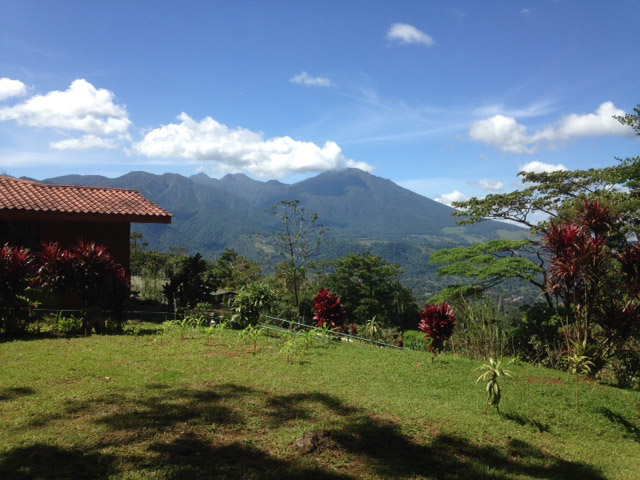Letters Home: A Gringa in Costa Rica, pt. 1
Part one – Heliconias Lodge – Swinging Bridges and Monkeys
People from northern New York know about living on the edge, that it takes a long time to get to our homes from the rest of the world but that perhaps we like it that way. It’s the same in northern Costa Rica.

View from Heliconias lodge of Miravalles volcano. Heliconias is a bright red tropical flower and they are planted all around the lodge. Photo: Betsy Kepes
We board a bus as dawn lights the city of San Jose, Costa Rica’s capital, a sprawling place in the middle of the country. It will take four hours of driving to reach the little northern town of Bihagua, four hours on a very crowded bus. We bought our tickets early and our assigned seats are the back row, where the bad boys usually sit. We are five Americans – my family and Helder Rocha from San Francisco. We’ll all be helping out at Heliconias Lodge, a family-run business at the edge of the rainforest, our work coordinated by Volunteers for Peace.
Costa Rica is about half the size of New York State but instead of old mountains it has new ones. Volcanoes fill the horizons and Costa Rica has generous amounts of land on both the Pacific Ocean and the Caribbean Atlantic. Half of the five million “Tica”s live in the San Jose region leaving the rest of the country largely rural. And a quarter of Costa Rica’s land is in national parks and reserves, hugely important for preserving its amazing biological diversity.
On our bus ride we see the land that is no longer native forest. After we get out of the city there’s lots of scruffy pasture and fields of a crop that looks like aloe – spiky plants in long rows. We’re traveling on Route One, a road that connects North and South America. The narrow two lane road is busy with trucks, buses, and cars. I’m glad I’m not driving.

Lee Van de Water hauling trail fill across hanging bridge. Taken from midpoint halfway up tree. Photo: Betsy Kepes
When the bus turns off Route One to the smaller road going north the landscape opens up, western-style, with Brahman cattle in the foreground and volcanoes behind them.
In Bihagua we stagger off the bus and are so glad to be out of the hard, narrow seats that we decide to walk the three kilometers up to Heliconias Lodge instead of hiring a taxi. The locals stare politely as we walk up the dirt road. Tourism is the major industry now in Costa Rica, ahead of agriculture, and “Eco-tourism” is the buzz word. We’re about to find out what it means.
The road climbs up and up and we’re grateful for the misty rain. Halfway up the hill we meet another group of gringos, a biology class from Quebec studying the rainforest and doing home-stays in Bihagua. HelloBonjour. The world seems a little smaller, in a good way.
The last half kilometer of the road enters the woods and the air fills with the sounds of birds and insects. And finally, we see Heliconias Lodge, a sprawl of wooden buildings set into the steep hillside.
We step inside the open air dining room and let Helder introduce us. He’s Portuguese-American and has told us that Spanish is close enough that he can understand it easily. The rest of us have almost no Spanish so we are extremely grateful to have Helder as our interpreter. It’s busy in the lodge, with guests eating lunch and others heading out on the rainforest walk. A small woman smiles at us, gives us the keys to two rooms and, as Helder explains, asks us to get out of the way for an hour or two, our first job as volunteers.
Sure, we can do that. Our quarters are above the main lodge, an old building with dorm rooms and a wide porch that includes two hammocks. Everything is a bit worn and we’ll discover that it’s this way on the whole property. In 1988 a group of families in Bihagua decided to try a tourist lodge rather than cut down more of the rainforest above their village. The protected land, 73 hectares, is adjacent to the Tenorio Volcano National Park. Almost twenty years later the project is down to eight families and Heliconias Lodge has gone from the only Eco-tourist accommodation in the area to one of several options. Fortunately the number of tourists has also risen and Heliconias is holding steady.
Soon enough, we meet the staff and by the next day we’re off on the trail, digging up red subsoil to put in feed bags and carry on our shoulders to dump in places the trail has eroded. The biggest challenge for me is crossing the long swinging bridge with a heavy bag on my back, but I love the return journey when I can look around. The rainforest is incredibly lush with vibrant birds and butterflies and flowers. Once a troop of white-faced monkeys swings through the trees above us, their long tails holding on to branches like extra hands.
Within a few days we’ve settled in. After an early breakfast of rice and beans we’re assigned jobs and work hard until lunch, more rice and beans. The afternoon work ends early enough that we have time to shower and hang out on our veranda before dinner’s rice and beans. Dark comes quickly in the tropics so we have our headlamps ready for evening reading. It is a peaceful rhythm in a beautiful quiet place where only the not-for-our-use lodge computer has access to the Internet.










So proud of my family….Betsy, Tom, Lee and Jay….doing good work to help the world!
Great to here what you guys are up to. Need pictures of bugs☺.